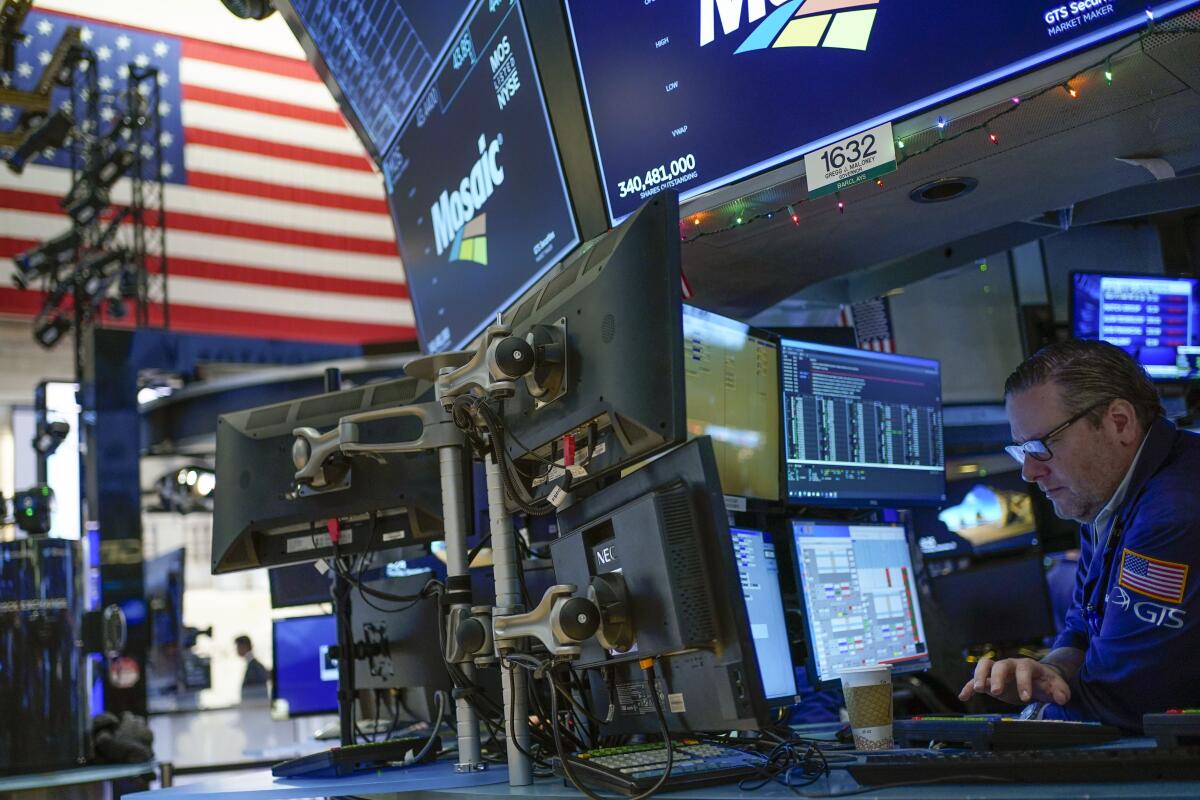U.S. stocks wrap up a dismal year with worst loss since 2008

- Share via
Wall Street capped a quiet day of trading with more losses Friday, as it closed the book on the worst year for the Standard & Poor’s 500 since 2008.
The benchmark index finished with a loss of 19.4% for 2022 — its worst loss since the financial crisis 14 years ago and a painful reversal for investors after the S&P 500 notched a gain of nearly 27% in 2021.
The Nasdaq composite racked up even bigger losses, sinking 33.1%. The index fared much worse because it is heavily made up of technology stocks, which led the broader market slump.
The Dow Jones industrial average, meanwhile, posted an 8.8% loss for 2022.
Stocks struggled all year as inflation put increasing pressure on consumers and raised concerns about economies slipping into recession.
Central banks raised interest rates to fight high prices. The Federal Reserve’s aggressive rate hikes remain a major focus for investors as central bank policymakers walk a thin line between raising rates enough to cool inflation, but not so much that they stall the U.S. economy into a recession.
Ready to save money and be debt-free in 2023? Learn to make (and stick to!) a budget and take control of your personal finances with our eight-part newsletter course, “Totally Worth It.” Here’s how to get started.
The Fed’s key lending rate stood at a range of 0% to 0.25% at the beginning of 2022 and will close the year at a range of 4.25% to 4.5% after seven increases. The U.S. central bank forecasts that the rate will reach a range of 5% to 5.25% by the end of 2023. Its forecast doesn’t call for a rate cut before 2024.
Russia’s invasion of Ukraine worsened inflation pressure earlier in the year by making oil, gas and food commodity prices even more volatile amid existing supply chain issues. China spent most of the year imposing strict COVID-19 policies that crimped production of raw materials and goods but is now in the process of removing travel and other restrictions.
The Fed’s battle against inflation, though, will probably remain the overarching concern in 2023, according to analysts. Investors will continue searching for a better sense of whether inflation is easing fast enough to take pressure off of consumers and the Fed.
If inflation continues to show signs of easing, and the Fed reins in its rate-hiking campaign, that could pave the way for a rebound for stocks in 2023, said Jay Hatfield, chief executive of Infrastructure Capital Advisors.
“The Fed has been the overhang on this market, really since November of last year, so if the Fed pauses and we don’t have a major recession we think that sets us up for a rally,” he said.
There was scant corporate or economic news for Wall Street to review Friday. That, plus the holiday-shortened week, set the stage for mostly light trading.
The S&P 500 fell 9.78 points, or 0.3%, to finish at 3,839.50. The index posted a 5.9% loss for the month of December.
The Dow dropped 73.55 points, or 0.2%, to close at 33,147.25. The Nasdaq slipped 11.61 points, or 0.1%, to 10,466.48.
Tesla rose 1.1%, as it continued to stabilize after steep losses earlier in the week. The electric vehicle maker’s stock plummeted 65% in 2022, its worst year ever.
Southwest Airlines, like so many American companies, spent money on dividends and stock buybacks instead of technology and infrastructure.
Southwest Airlines rose 0.9% as its operations returned to relative normalcy following massive cancellations over the holiday period. The stock still ended down 6.7% for the week.
Energy stocks held up better than the rest of the market as U.S. crude oil prices settled 2.4% higher. The sector notched a 59% gain for the year, while the other 10 sectors in the S&P 500 finished 2022 in the red.
Small company stocks also fell Friday. The Russell 2000 shed 5 points, or 0.3%, to close at 1,761.25.
Bond yields mostly rose. The yield on the 10-year Treasury, which influences mortgage rates, rose to 3.88% from 3.82% late Thursday.
Several big updates on the employment market are on tap for the first week of 2023. It has been a particularly strong area of the economy and has helped create a bulwark against a recession.
That has made the Fed’s job more difficult, though, because strong employment and wages mean it may have to remain aggressive to keep fighting inflation. That, in turn, raises the risk of slowing the economy too much and bringing on a recession.
The Fed will release minutes from its latest policy meeting on Wednesday, potentially giving investors more insight into its next moves.
The government will also release its November report on job openings Wednesday. That will be followed by a weekly update on unemployment on Thursday. The closely watched monthly employment report is due Friday.
Wall Street is also waiting on the latest round of corporate earnings reports, which will start flowing in around the middle of January.
Companies have been warning investors that inflation will probably crimp their profits and revenue in 2023. That’s after spending most of 2022 raising prices on many items in an effort to offset inflation, though many companies went further and actually padded their profit margins.
Companies in the S&P 500 are expected to broadly report a 3.5% drop in earnings during the fourth quarter, according to FactSet. Analysts expect earnings to then remain roughly flat through the first half of 2023.
U.S. stock markets will be closed Monday in observance of the New Year’s Day holiday.
More to Read
Inside the business of entertainment
The Wide Shot brings you news, analysis and insights on everything from streaming wars to production — and what it all means for the future.
You may occasionally receive promotional content from the Los Angeles Times.












